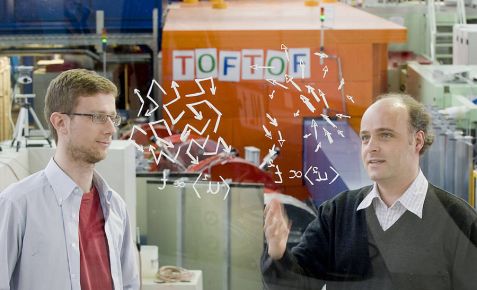MLZ is a cooperation between:
 > Technische Universität München
> Technische Universität München > Helmholtz-Zentrum Hereon
> Helmholtz-Zentrum Hereon
 > Forschungszentrum Jülich
> Forschungszentrum Jülich
MLZ is a member of:
 > LENS
> LENS > ERF-AISBL
> ERF-AISBL
MLZ on social media:

MLZ (eng)
Lichtenbergstr.1
85748 Garching
Phospholipids: flowing together, not leaping alone
Phospholipids are of great interest as they are a major component of the lipid bilayer in cell membranes. The latter contain embedded proteins which are responsible for diverse signal transduction processes.
How these phospholipids move within cell membranes and how they bring proteins into contact with each other has puzzled scientists for the last decade. For years, biophysicists pursued the wrong model: instead of leaping individually from one void to the next, it is now understood that the membrane’s phospholipids actually flow collectively in groups.
Finnish scientists working with Ilpo Vattulainen first put forward the proposal that phospholipids exhibited flow-like motions in 2008, using molecular dynamic simulations of dipalmitoylphosphatidylcholine bilayers in the fluid phase. German scientists, Dr. Sebastian Busch and Dr. Tobias Unruh, at the FRM II actually proved the Finns’ theory with measurements taken using the time-of-flight neutron spectrometer TOFTOF in 2009 using the commonplace phospholipid dimyristoylphosphatidylcholine (DMPC). They were also able to demonstrate the flowing motion of the molecules in neutron scattering experiments. The cell membrane molecules move in a similar way to people in a crowd: only when a group of them moves in one direction can an individual also take a step forward. Therefore, there are no molecules that jump around on their own – they are only able to flow collectively as a group.
The physicist Dr. Sebastian Busch studied DMPC, hydrated with heavy water. He observed the motion of the cell membrane at 30 °C on a time scale between 35 and 1,000 picoseconds. When the TOFTOF spectrometer is used, neutrons with a precisely determined velocity are selected. The neutron beam hitting the sample interacts with the atomic nuclei. The motion of the latter results in a change in the speed of the neutrons after interaction, which can be measured with a detector. So far, TOFTOF is the only spectrometer worldwide that is able to measure these tiny movements on the nanoscale with such high precision.
The study of the change in motion of the phospholipids when mixed together with various substances will be conducted next. Mixtures of this type are used in drugs, for example. Suitable additives can significantly increase the stability of the drugs. If the stabilizing mechanism is unravelled, optimized mixtures for individual applications can be proposed in future.
Original publication
Molecular Mechanism of Long-Range Diffusion in Phospholipid Membranes Studied by Quasielastic Neutron Scattering, S. Busch, C. Smuda, L.C. Pardo Soto, T. Unruh, Journal of the American Chemical Society, Publication Date (Web): February 17, 2010 DOI: 10.1021/ja907581s
Link to the simulation by the Finnish scientists on YouTube:
MLZ is a cooperation between:
 > Technische Universität München
> Technische Universität München > Helmholtz-Zentrum Hereon
> Helmholtz-Zentrum Hereon
 > Forschungszentrum Jülich
> Forschungszentrum Jülich
MLZ is a member of:
 > LENS
> LENS > ERF-AISBL
> ERF-AISBL
MLZ on social media:




